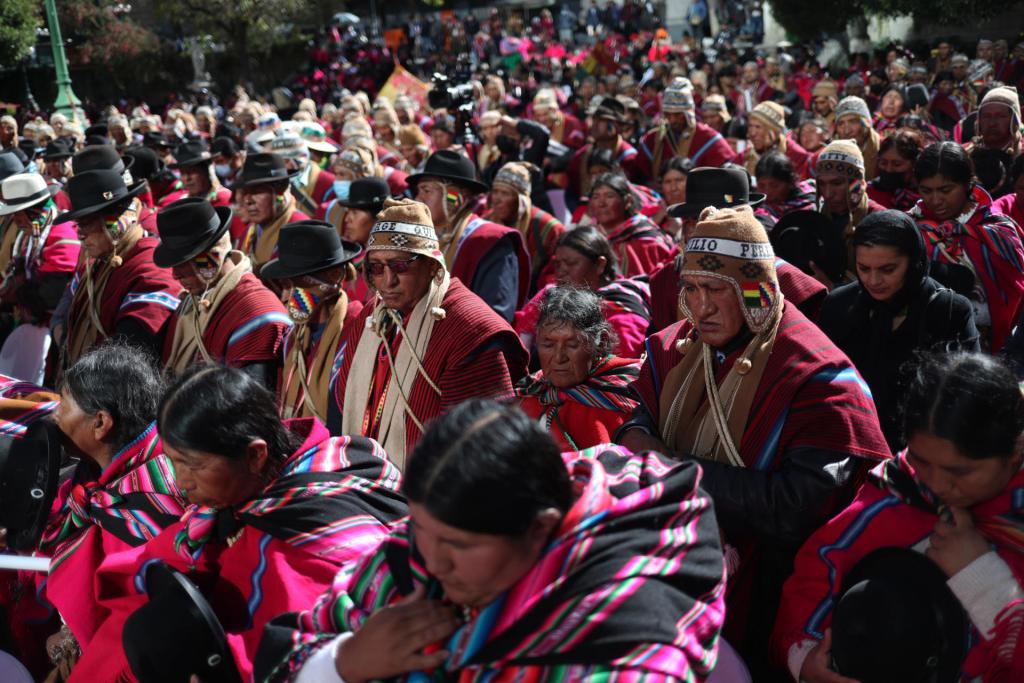La Paz, (EFE).- Native music, invocations in Aymara and an ancestral ritual marked the launch in La Paz of the celebration of the Andean New Year 5531, whose epicenter will be in the pre-Hispanic citadel of Tiahuanaco, which is preparing for the celebration in the it was post-pandemic.
Preceded by their local and native authorities, hundreds of indigenous people from the Tiahuanaco communities toured the historic center of La Paz until they reached Plaza Murillo, the seat of Bolivian political power, to present the celebrations for the “Willkakuti” or return of the sun that They will take place on June 21.
Ahead of them was also a group of native musicians accompanied by kusillos, characters from the Andean culture similar to harlequins or buffoons, who performed a “pinkillada”, a native son of the Bolivian Altiplano that is played with pinkillos or Andean flutes and drums.
In the square, some “amautas” or indigenous wise men were waiting who led the rituals to deliver an offering to the “Pachamama” or Mother Earth.
The director of the Center for Archaeological, Anthropological Research and Administration of Tiahuanaco (Ciaaat), Gonzalo Choque, told EFE that the covid-19 pandemic left the celebrations “with a parenthesis”, but now that the circumstances are different, they are looking for revive ancestral customs “with greater force”.
“Unfortunately due to health issues we have been restricted, always carefully, we have complied with the rules. So now we also have to be able to revive, reactivate tourism and our heritage, show our cultures, ”he said.
According to the official, people are “encouraged” and “happy” at the “Wilkakuti” celebration in Tiahuanaco, which is expected to attract visitors from other Bolivian regions and also from abroad.
The “jach’a mallku” or highest authority originating from the marka or place of Tiahuanaco, Raúl Yura, highlighted the importance of the archaeological site that is charged with a lot of “spirituality”, “magic” and “cosmic energy”.
“Tiahuanaco has a high relevance, very little has been excavated, but the most important thing is the living heritage. The original authorities still have many concepts of living culture and that is what we want to highlight ”, he affirmed.

Yura stated that, despite the changes generated by the climate crisis, the indigenous people will always ask “Father Sun, Mother Earth for good times”, especially on occasions such as the “Willkakuti”.
center and tradition
Tiahuanaco, which has been a World Heritage Site since 2000, is located almost 80 kilometers from La Paz and was the capital of the ancient pre-Hispanic empire of the same name.
At present there are impressive lithic monuments such as the Kalasasaya temple, the Semi-subterranean Temple, sculptures of its hierarchs, the Puerta del Sol and remains of military and civil palaces.
To celebrate the Andean New Year, people usually go before dawn to sites considered sacred, such as Tiahuanaco, to receive the first rays of the sun with their palms raised.
The celebration, which also marks the change in the agricultural cycle for planting in the fields, coincides with the southern winter solstice, when the shortest day and longest night take place in the Southern Hemisphere.
The name of the festival has evolved with inclusion criteria, since it began to be celebrated a few decades ago in Tiahuanaco as Aymara New Year, then it was called Aymara-Quechua New Year and later Andean New Year.
In 2009, the Government of Evo Morales baptized the celebration as the Amazon Andean New Year and decreed that every June 21 be a national holiday, and in 2017 the name included the Chaco area.






